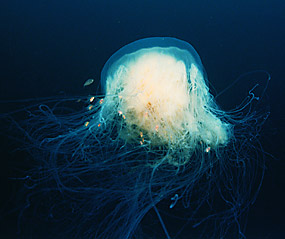![[Ocean Oasis Field Guide]](images/bnr-oo-field.gif)

![[Ocean Oasis Field Guide]](images/bnr-oo-field.gif) |  |
|
Phacellophora camtschatica |
Phylum Cnidaria |
DescriptionJellyfish have a gelatinous consistency and their tissues are 95% water. The bell in fried egg jellies measures about 60 cm (24 inches) in diameter. The transparent margin consists of 16 large lobes that alternate with small lobes, each lobe containing clusters of up to 25 tentacles. These tentacles can measure up to 6 m (20 feet) long. Phacellophora is often confused with the Lion's mane jellyfish (Cyanea capillata). Size: To capture their zooplankton food, jellies discharge harpoon-like stingers coiled inside a fluid-filled capsule — the nematocyst. The tentacles of jellyfish are covered by thousands of nematocysts. This stinging apparatus is characteristic of the phylum Cnidaria (e.g. jellyfish, corals, sea anemones.) Range and HabitatPelagic, from Alaska to southern California, worldwide in temperate oceans. Natural HistoryThe bell in this species looks like a fried egg with a broken yolk — hence, its common name. While drifting, this jelly pulsates the bell slowly and spends some time motionless. Small juvenile jacks can often be seen swimming among the tentacles. The fried egg jellyfish may also have juvenile crabs and amphipods living on top of and underneath the bell. |

Good illustrations of the parts of a jellyfish can be found at |
Text by Patricia Beller
Photograph from Ocean Oasis © 2000 CinemaCorp of the Californias
Field Guide |
Site Index |
Ocean Oasis Introduction
|
|
© 2000 San Diego Natural History Museum |